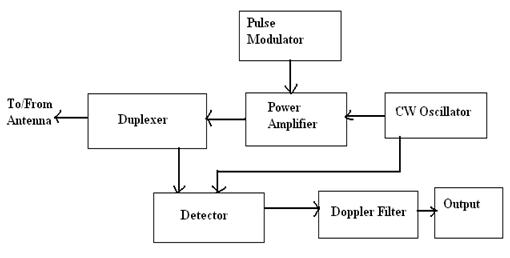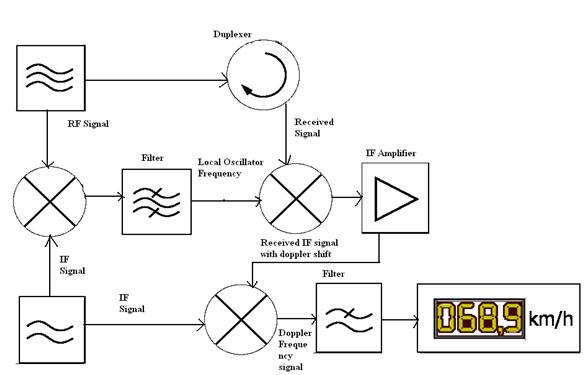Radar system can generally consists of a transmitter which can produce electromagnetic signal and which is radiated into space using an antenna. When this signals strikes an object it reflects into many directions. This reflect signal is received by the radar antenna.
THERE ARE 6 MAJOR PARTS OF RADAR SYSTEM.
A Transmitter: It can be a power amplifier like a Klystron, Travelling Wave Tube or a power Oscillator like a Magnetron. The signal is first generated using a waveform generator and then amplified in the power amplifier.
Waveguides: The waveguides are transmission lines for transmission of the RADAR signals.
Antenna: The antenna used can be a parabolic reflector, planar arrays or electronically steered phased arrays.
Duplexer: A duplexer allows the antenna to be used as a transmitter or a receiver. It can be a gaseous device that would produce a short circuit at the input to the receiver when transmitter is working.
Receiver: It can be super heterodyne receiver or any other receiver which consists of a processor to process the signal and detect it.
Threshold Decision: The output of the receiver is compared with a threshold to detect the presence of any object.
Waveguides: The waveguides are transmission lines for transmission of the RADAR signals.
Antenna: The antenna used can be a parabolic reflector, planar arrays or electronically steered phased arrays.
Duplexer: A duplexer allows the antenna to be used as a transmitter or a receiver. It can be a gaseous device that would produce a short circuit at the input to the receiver when transmitter is working.
Receiver: It can be super heterodyne receiver or any other receiver which consists of a processor to process the signal and detect it.
Threshold Decision: The output of the receiver is compared with a threshold to detect the presence of any object.
TYPES OF RADAR SYSTEM:
1) Pulsed RADAR 2) Continuous Wave RADAR
Pulse RADAR: Pulsed RADAR sends high power and frequency pulses towards the target object. The range will depends on pulse repetition frequency.
Continuous Wave RADAR: The continuous wave RADAR doesn’t measures the range of the target but rather the rate of change of range by measuring the Doppler shift of the return signal.
RADAR APPLICATIONS IN 5 AREAS:
Military Applications: In Air defense as it is used for target detection.
Air Traffic Control: It is to guide the aircraft to land in bad weather using precision approach radar.
Remote Sensing: Radar can be used for observing weather.
Ground Traffic Control: RADAR can also be used by traffic police to determine speed of the vehicle.
Space: To guide the space vehicle for safe landing on moon.
A Overview about the Pulsed RADAR
Pulsed RADAR sends high power and high frequency pulses towards the target object. It then waits for the echo signal from the object before another pulse is send. The range and resolution of the RADAR depends on the pulse repetition frequency. It uses the Doppler shift method.
The principle of RADAR detecting moving objects using the Doppler shift works on the fact that echo signals from stationary objects are in same phase and hence get cancelled while echo signals from moving object will have some changes in phase.
Two types of Pulsed RADAR are:
Pulse Doppler RADAR: It transmits high pulse repetition frequency to avoid Doppler ambiguities. The transmitted signal and the received echo signal are mixed in a detector to get the Doppler shift and the difference signal is filtered using a Doppler filter where the unwanted noise signals are rejected.
Moving Target Indicator RADAR: It transmits low pulse repetition frequency to avoid range ambiguities. In a MTI RADAR system, the received echo signals from the object are directed towards the mixer, where they are mixed with the signal from a stable local oscillator (STALO) to produce the IF signal. This IF signal is amplified and then given to the phase detector where its phase is compared with the phase of the signal from the Coherent Oscillator (COHO) and the difference signal is produced. The Coherent signal has the same phase as the transmitter signal. The coherent signal and the STALO signal are mixed and given to the power amplifier which is switched on and off using the pulse modulator.
An Overview about the Continuous Wave RADAR
The continuous wave RADAR doesn’t measures the range of the target but rather the rate of change of range by measuring the Doppler shift of the return signal. In a CW RADAR electromagnetic radiation is emitted instead of pulses. It is basically used for speed measurement.
The RF signal and the IF signal are mixed in the mixer stage to generate the local oscillator frequency. The RF signal is the transmitted signal and the received signal by the RADAR antenna consists of the RF frequency plus the Doppler shift frequency. The received signal is mixed with the local oscillator frequency in the second mixture stage to generate the IF frequency signal. This signal is amplified and given to the third mixture stage where it is mixed with the IF signal to get the signal with Doppler frequency. This Doppler frequency or Doppler shift gives the rate of change of range of the target and thus the velocity of the target is measured.
RADAR Applications in 5 Areas:
Military Applications:
The RADAR has 3 major applications in Military:
- In air defense it is used for target detection, target recognition and weapon control (directing the weapon to the tracked targets).
- In missile system to guide the weapon.
- Identifying enemy locations in map.
Air Traffic Control:
The RADAR has 3 major applications in Air Traffic control:
- To control air traffic near airports. The Air Surveillance RADAR is used to detect and display the aircraft’s position in the airport terminals.
- To guide the aircraft to land in bad weather using Precision Approach RADAR.
- To scan the airport surface for aircraft and ground vehicle positions
Remote Sensing: RADAR can be used for observing weather or observing planetary positions and monitoring sea ice to ensure smooth route for ships.
Ground Traffic Control: RADAR can also be used by traffic police to determine speed of the vehicle, controlling the movement of vehicles by giving warnings about presence of other vehicles or any other obstacles behind them.
Space:
RADAR has 3 major applications:
- To guide the space vehicle for safe landing on moon
- To observe the planetary systems
- To detect and track satellites
- To monitor the meteors



No comments:
Post a Comment